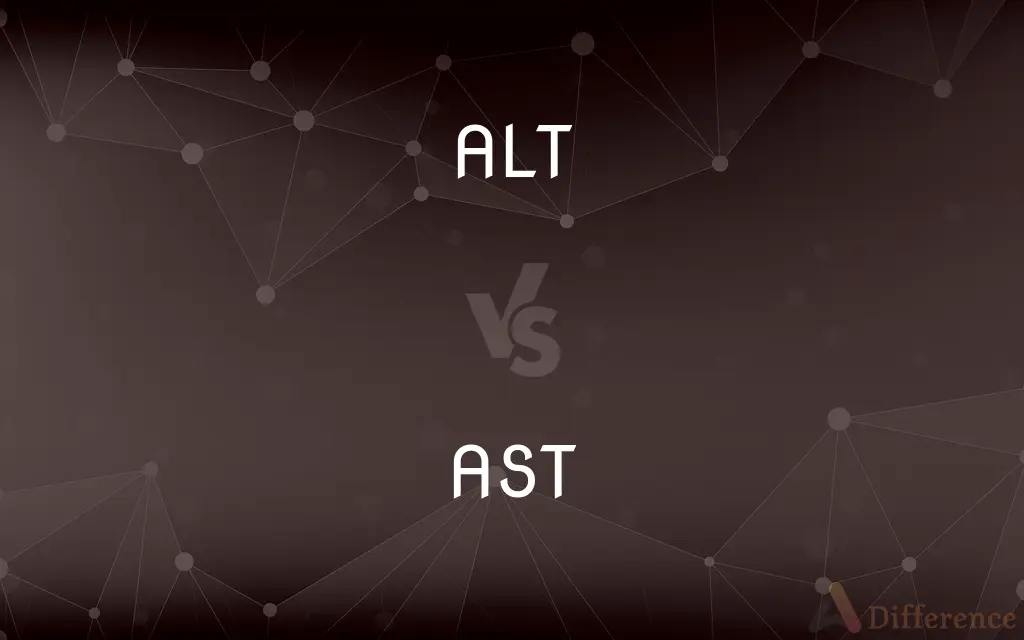ALT vs. AST — What's the Difference?
By Tayyaba Rehman — Published on November 12, 2023
ALT (Alanine Aminotransferase) and AST (Aspartate Aminotransferase) are liver enzymes. ALT is more specific to the liver, while AST is also found in the heart, muscles, and kidneys.

Difference Between ALT and AST
Table of Contents
ADVERTISEMENT
Key Differences
ALT and AST are both enzymes that play a crucial role in the conversion of amino acids in the liver. ALT stands for Alanine Aminotransferase, while AST stands for Aspartate Aminotransferase. These enzymes are used as indicators of liver health.
In the context of liver health, the presence of elevated ALT levels typically signifies liver damage or inflammation. AST levels can also indicate liver issues but are less specific as they might be raised due to conditions affecting other organs.
While ALT is predominantly found in the liver, meaning its elevation is a more direct sign of liver damage, AST is not exclusive to the liver. AST can also be found in significant amounts in the heart, muscles, and kidneys.
In medical tests, the ratio of ALT to AST can be essential in determining the cause of liver damage. A higher ALT than AST suggests problems like fatty liver disease or hepatitis. When AST is higher than ALT, it might indicate issues like alcoholic liver disease or muscle damage.
From a diagnostic perspective, evaluating both ALT and AST levels together provides a clearer picture of liver health. While both enzymes can be elevated due to liver issues, the context in which they rise and their relative proportions can indicate different underlying conditions.
ADVERTISEMENT
Comparison Chart
Full Form
Alanine Aminotransferase
Aspartate Aminotransferase
Specificity
More specific to the liver
Found in liver, heart, muscles, and kidneys
Indication of Damage
Elevated levels suggest liver damage or inflammation
Less specific indication of liver damage
Diagnostic Ratio
Higher ALT suggests issues like fatty liver
Higher AST indicates alcoholic liver disease
Function
Amino acid conversion in the liver
Amino acid conversion in various organs
Compare with Definitions
ALT
A common element in liver function tests.
She had her ALT levels checked as part of her annual check-up.
AST
An enzyme found in the liver and other organs.
AST levels can rise due to liver or muscle damage.
ALT
Stands for Alanine Aminotransferase.
Medical students learn about ALT in their biochemistry courses.
AST
Often used alongside ALT to assess liver health.
The ratio of ALT to AST helps diagnose certain liver conditions.
ALT
A key indicator of liver health and function.
High ALT levels may hint at underlying liver diseases.
AST
Abbreviation for Aspartate Aminotransferase.
Elevated AST levels can be a sign of multiple health issues.
ALT
A protein involved in amino acid conversion within the liver.
ALT plays a crucial role in the liver's metabolic processes.
AST
Involved in the metabolism of amino acids.
AST has a role in the body's nitrogen metabolism.
ALT
Pitched in the first octave above the treble staff; high.
AST
A frequent element in comprehensive metabolic panels.
The doctor ordered an AST test to see the overall health of the liver.
ALT
Espousing or reflecting values different from those of the establishment or of mainstream culture. Often used in combination
Alt-rock music.
An alt-weekly newspaper.
AST
Pronunciation spelling of asked
ALT
Existing outside traditional or established institutions or systems. Often used in combination
Alt-fuels.
An alt-lifestyle.
ALT
The first octave above the treble staff.
ALT
A note or tone in the alt octave.
ALT
The Alt key.
ALT
(music) High pitch, of a voice or instrument; especially, the octave above the top line of the treble stave.
ALT
A state of excitement, a heightened emotional condition.
ALT
Clipping of altitude
ALT
An alternate or secondary character.
ALT
(Internet slang) An alternate account.
ALT
(finance) An alternative investment or alternative fund.
Liquid alts
ALT
Synonym of altbier
ALT
Clipping of alternate
ALT
Clipping of alternativeespecially as a cultural phenomenon seen as being outside the mainstream of its genre.
Alt medicine
ALT
The higher part of the scale. See Alto.
ALT
Angular distance above the horizon (especially of a celestial object)
Common Curiosities
Why is ALT important in medical tests?
ALT levels indicate liver health, with elevated levels suggesting liver damage or inflammation.
How does AST differ from ALT in terms of location?
While both are in the liver, AST is also found in the heart, muscles, and kidneys.
Why is the AST to ALT ratio significant?
It can help determine the cause of liver damage, with different ratios hinting at various conditions.
What does ALT stand for?
ALT stands for Alanine Aminotransferase.
What is the primary function of ALT?
ALT is involved in amino acid conversion within the liver.
What is considered a normal range for ALT and AST?
Normal ranges can vary by lab but typically fall between 7-56 units per liter of serum for ALT and 5-40 units for AST.
Is AST a reliable standalone indicator of liver health?
Not as reliable as ALT; it's best to consider AST levels alongside ALT for a clearer liver health picture.
Can medication affect ALT and AST levels?
Yes, some medications can cause elevations in these enzymes.
Is ALT found only in the liver?
While ALT is primarily in the liver, trace amounts can be found elsewhere.
Can ALT levels rise due to reasons other than liver damage?
Yes, although it's primarily a liver enzyme, conditions affecting other organs might cause slight ALT elevation.
Can physical activity affect AST levels?
Yes, intense muscle activity can cause temporary increases in AST levels.
Can high AST levels indicate non-liver issues?
Yes, high AST can result from problems affecting the heart, muscles, or other organs.
Are there ways to reduce elevated ALT and AST levels?
Yes, addressing the underlying cause, such as abstaining from alcohol or changing medications, can help.
What does AST stand for?
AST stands for Aspartate Aminotransferase.
Share Your Discovery

Previous Comparison
Oscar Award vs. Emmy Award
Next Comparison
Nernst Potential vs. Zeta PotentialAuthor Spotlight
Written by
Tayyaba RehmanTayyaba Rehman is a distinguished writer, currently serving as a primary contributor to askdifference.com. As a researcher in semantics and etymology, Tayyaba's passion for the complexity of languages and their distinctions has found a perfect home on the platform. Tayyaba delves into the intricacies of language, distinguishing between commonly confused words and phrases, thereby providing clarity for readers worldwide.












































